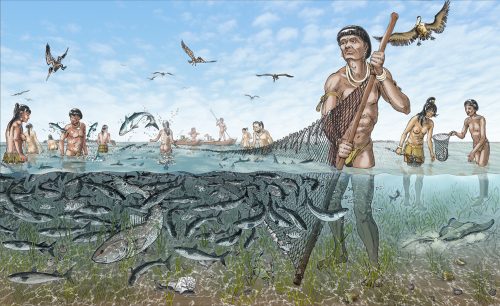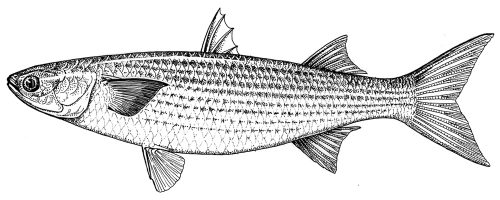A hallmark of complex human societies is the existence of surplus foods. Surplus foods enable people, past and present, to spend time on things other than producing food.

Mullet, especially the striped mullet (Mugil cephalus), because of their predictable, mass-schooling behavior and preservability via dry-smoking, is the most likely fish to have provided a surplus food for southwest Florida’s non-agricultural Calusa people. Moreover, López de Velasco, writing in about 1570, stated that there was in southwest Florida a “great fishery of mullet [licias], which [the Indians] catch in nets as in Spain.”
And yet, mullet remains were not recorded as particularly abundant in archaeological sites of the region. Moreover, mullet bones were no more numerous than bones or individual counts of many other kinds of fishes.
My original conclusion in 1992, published in Culture and Environment in the Domain of the Calusa, was that in the subtropical Pine Island Sound region, finfish and shellfish were diverse and abundant year-round, so perhaps there was no need for a storable surplus. Results from analyses of Pineland samples, published in 2013 in The Archaeology of Pineland, did not change my position.
However, the 1570 Velasco statement bothered me for many years. What if sample size made a difference? What if other biases existed? What about time periods?
The majority of the earlier work which indicated little support for a substantial mullet fishery was derived from sites located across the region. They were small samples, measuring 50x50x10 cm and involved fine-mesh screening, the use of screen about the size of window screen.
I turned my attention to other curated Pineland samples. Since about 1990, many volunteers hand-collected and cleaned all animal bones, including fish otoliths, from 1/4- inch-mesh screens during various Pineland excavations. These samples were from larger areas, often 200x200x10 cm. The resulting hundreds of bags of bone were given catalog numbers, boxed and shelved at our parent museum, the Florida Museum, at the University of Florida (UF), in Gainesville. Over the years, UF students taking the graduate Zooarchaeology course were assigned some of these samples to analyze and report on. I chose the samples so that different time periods, ranging from the Caloosahatchee I-late (A.D. 1-500) through Caloosahatchee IV (A.D. 1350-1500) periods would be represented.
As the number of analyzed samples increased, what emerged was a pattern where the samples dating to the latest time period, Caloosahatchee IV, the height of Calusa society, contained significantly more mullet remains. Although I could not be certain of the accuracy of the student work, I was intrigued that this suggested support for Velasco’s observation.
Thus, as part of a recent, broader, collaborative National Science Foundation funded study with the University of Georgia (Victor Thompson), Florida Gulf Coast University (Mike Savarese), and the Florida Museum (William Marquardt), I had the opportunity to re-evaluate my earlier conclusion and again ask, “Did the Calusa have a great fishery of mullet?”

To do this, I re-examined a selection of the fine-screened, smaller samples that had been analyzed by several people, including myself, and another selection of the coarse-screened, larger samples analyzed by students. Samples came from Pineland, Mound Key, and other sites. The overall result was that re-analysis resulted in increased numbers of identified mullet bones (NISP: Number of Identified Specimens) and number of individual mullets (MNI: Minimum Number of Individuals). This was true also for the percentage of mullet remains relative to all fishes.
Several sources of bias likely explain the dampened mullet numbers of the earlier work. First, small sample and screen sizes tend to produce large numbers of remains from very small fishes. One sample, for example, can contain the bones of a couple of hundred pinfish, which grow to only several inches long, but those of only one, much larger mullet, which de-emphasizes the mullet. Balancing these samples with the larger, coarse-screened samples is needed.
Analyst variability is another bias, even with larger samples. Because mullet vertebrae preserve well and the thoracic ones are easiest to identify, a common short-cut method of figuring MNI was used in the earlier work. An average of 11 thoracic vertebrae was used to represent one individual, and if 12 or more were found, then 2 individuals were counted, and so on. And if one’s interpretive focus is on MNI rather than NISP, then one might not bother identifying the remaining vertebrae, all of which are also identifiable with close study. The shortcut results in undercounted specimens (NISP).
The nature of the mullet’s skeleton itself is likely another factor in earlier results. In many fishes, the highly diagnostic elements of dentaries, premaxillae, and otoliths are frequently found and identified, accounting for many MNIs. Mullet mouthparts and otoliths, however, are very fragile and rarely recovered, especially by the coarser screens. Also, the mullet atlas is unlike the classic fish atlas; it is similar in form to other vertebrae and is easily missed.
Thus, the re-analysis demonstrates that mullet remains were underrepresented in the earlier work. It also confirms the pattern of more mullet during the Caloosahatchee IV time period. But with 14% NISP and 23% MNI being the “high” percentages of mullet for all fishes consumed at Pineland, these numbers do not translate to a “great fishery of mullet.” Interestingly, though, the Mound Key results produced higher mullet percentages for the IV period with the latest two samples showing 35% NISP and 58% MNI as the high percentages of mullet for all fishes consumed. Although more analyzed samples in the future may alter this view, for now it appears that the “great mullet fishery” of the Calusa may have been a late phenomenon and one centered at Mound Key more-so than at Pineland.